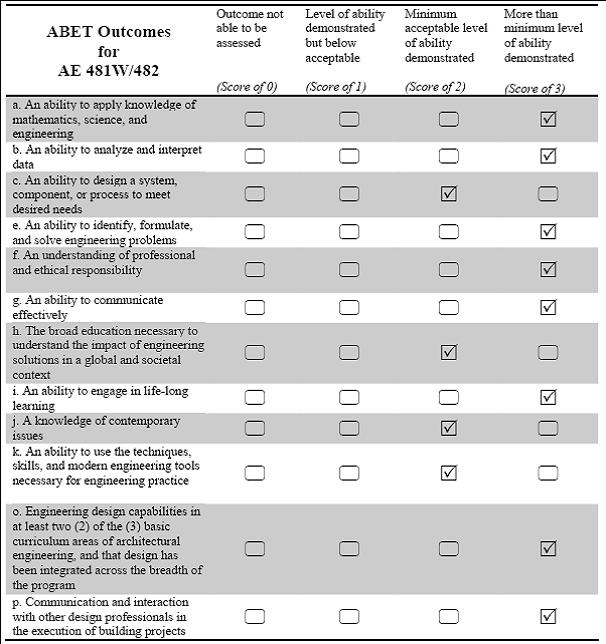
![]()
Course Reflection | CPEP Reflection | ABET Assessment
AE 481W/482
Course Reflection
Senior thesis encompasses two semesters and ends with a presentation to
a committee of AE faculty members. The thesis experience actually begins
once a building of choice is approved which for me was March before my
senior year. I chose to use the Penn State Ballpark because I would be
working on the project for the project's duration and would have the ability
to use the necessary resources on a daily basis. During the summer months,
I had the opportunity to attend design meetings, bid review meetings,
and job conferences which helped me to develop a better understanding
of the project. Throughout the entire thesis experience, I utilized the
many of my resources from the project to help gain a better understanding
with the technical areas associated with my thesis work.
Because I worked daily on the project, the fall semester proved to be undemanding and tedious. Since the fall semester is researching the project, I already had many of the assignments (project background, estimate, schedule, etc.) already at my disposal from the preconstruction activities I assisted with. The fall semester concluded with a thesis proposal submission which proved to be very valuable while completing work during the spring semester.
Upon returning from an enjoyable winter break that included a trip to Miami for the Orange Bowl, getting back to work on thesis was quite a challenge. However, after an additional two week vacation, I realized it was time to get to work. After planning the rest of the semester with the needed areas of work, I began to make the uphill climb to complete my senior thesis project. I looked at three interesting facets associated with the Ballpark: field lighting columns (structural breadth), electrical distribution to retail building (electrical breadth), and streamlining the structural steel design to construction through computer modeling (construction depth). I spent the majority of the semester thoroughly working through the areas associated wtih my thesis.
Ultimately, I found the thesis experience to be very valuable and enjoyable.
I was able to practice areas associated with a constructability review
which will be very valuable upon graduating. I gained advice from faculty
and industry regarding my work throughout the development and presentation
process which will also benefit my career. Furthermore, I hope to use
the knowledge I gained from the construction research topic upon entering
the construction industry.
CPEP &
Discussion Board Reflection
The Capstone Project e-Portfolio (CPEP) has allowed me to present my senior
thesis research and results online. While an initial template was provided
to organize the website, I took the liberty to customize and personalize
the webpage design. The webpage was maintained and updated over the course
of two semesters to reflect the most current work and obtain feedback
from consultants. The discussion boards allowed me to communicate with
industry professionals in hopes of providing a better understanding of
my thesis research topics.
Constructing the CPEP website allowed me to express creativity and my understanding of webpage design from previous experience. Initially, I spent countless hours with the webpage design and images, but once that was complete, maintaining the site proved to be simple. Through the use of the CPEP, many of my family members, co-workers, and industry representatives were able to access my on-going work and provide feedback as necessary which could not have easily occurred with another format.
Because of the daily resources I had at the constrution site, I did not use the discussion boards and therefore have no opinion with that area of thesis.
The CPEP website and discussion boards have not necessarily made me a
better student, but they have taught me the importance of visual display
and serve as a lasting record to my semester long accomplishments. Furthermore,
the knowlege of webpage design will be beneficial as the construction
industry continues to implement technological advances on a project.
Accreditation Board
for Engineering and Technology (ABET) Assessment
ABET, Inc., is the recognized U.S. accreditor of college and university
programs in applied science, computing, engineering, and technology. Accreditation
ensures the quality of the postsecondary education students receive. ABET
was established in 1932 and is now a federation of 28 professional and
technical societies representing the fields of applied science, computing,
engineering, and technology. Through the hard work and dedication of more
than 1,500 volunteers, ABET currently accredits some 2,700 programs at
over 550 colleges and universities nationwide. Visit the ABET
website for more information.

ABET Assessment
2006 (PDF 21KB)
The Capstone Project Electronic Portfolio (CPEP) is a web-based project and information center. It contains material produced for a year-long Senior Thesis class. Its purpose, in addition to providing central storage of individual assignments, is to foster communication and collaboration between student, faculty consultant, course instructors, and industry consultants. This website is dedicated to the research and analysis conducted via guidelines provided by the Department of Architectural Engineering. For an explanation of this capstone design course and its requirements click here.
Senior
Thesis | The Pennsylvania
State University | Architectural Engineering | AE Lab | Contact Jason McFadden
This Page was last updated on
April 30, 2006
by Jason McFadden and is hosted by the AE
Department © 2005
Note: While great efforts have been taken to provide accurate and complete information on the pages of CPEP, please be aware that the information contained herewith is considered a work-in-progress for this thesis project. Modifications and changes related to the original building designs and construction methodologies for this senior thesis project are solely the interpretation of Jason McFadden. Changes and discrepancies in no way imply that the original design contained errors or was flawed. Differing assumptions, code references, requirements, and methodologies have been incorporated into this thesis project; therefore, investigation results may vary from the original design.













